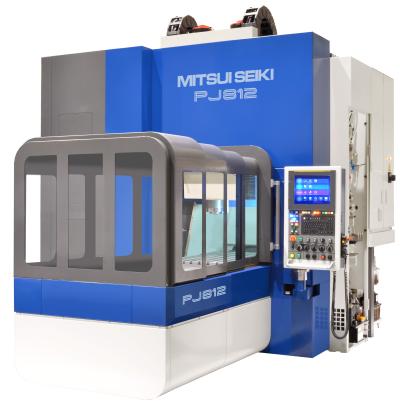
The new Mitsui Seiki PJ812 Precision Profile Center is a 3-axis CNC vertical jig mill engineered to perform high-precision contour machining and ultra precise boring of components with critical tolerances. It is ideal for processing parts for the mold and die, optical, aerospace and medical industries.
The PJ812 machining center provides positioning accuracy and repeatability of +/-1µm. A thermal-compensation system employs sensors on the machine faceplate and inside the spindle to minimize the effects of temperature changes on part accuracy and cut temperature-generated displacement by 60 percent. This system also reduces Z-axis thermal growth and deflection by 30 percent. Cooling systems for slideway lubrication and ballscrew cores stabilize axis feed precision.
Mechanical design features that maximize machine rigidity and accuracy include hardened and ground tool steel box slideways as well as contact elements that enhance acceleration, reduce stick-slip, and allow for feed accuracy of 0.1 µm. Another proprietary engineering detail drastically improves the static rigidity of the Z-axis to more than six times that of conventional Z-axis arrangements.
The PJ812 machining center spindle choices include 10,000 rpm with 50-Taper with 30/15 kW (40/20 hp) direct drive motors and up to 30,000 RPM, 18/15 kW (24/20 hp) with 40-Taper. X-, Y- and Z-axis travels are 1,200mm (48"), 800mm (32"), and 500 mm (20") respectively. The machine table can accommodate a maximum load of 1,500 kg (3,300 lbs) on its 1,200 mm (48") x 800 mm (32") work surface. Overall machine footprint is 4,720 mm (189") by 3,000 mm (120"). A 40-tool capacity ATC is standard.
The fully enclosed machine enclosure allows for complete containment of chips and coolant, while affording excellent work loading and setup ergonomics, according to the company.
The PJ812 possesses an energy-saving circuit that reduces electric power consumption by up to 90 percent and compressed air consumption by up to 40 percent. The latest FANUC 31iM-B CNC is equipped with a new HMI and a 500mm (19") LCD touch screen for ease of operation for setup and at-machine programming.
Contact Details
Related Glossary Terms
- boring
boring
Enlarging a hole that already has been drilled or cored. Generally, it is an operation of truing the previously drilled hole with a single-point, lathe-type tool. Boring is essentially internal turning, in that usually a single-point cutting tool forms the internal shape. Some tools are available with two cutting edges to balance cutting forces.
- computer numerical control ( CNC)
computer numerical control ( CNC)
Microprocessor-based controller dedicated to a machine tool that permits the creation or modification of parts. Programmed numerical control activates the machine’s servos and spindle drives and controls the various machining operations. See DNC, direct numerical control; NC, numerical control.
- coolant
coolant
Fluid that reduces temperature buildup at the tool/workpiece interface during machining. Normally takes the form of a liquid such as soluble or chemical mixtures (semisynthetic, synthetic) but can be pressurized air or other gas. Because of water’s ability to absorb great quantities of heat, it is widely used as a coolant and vehicle for various cutting compounds, with the water-to-compound ratio varying with the machining task. See cutting fluid; semisynthetic cutting fluid; soluble-oil cutting fluid; synthetic cutting fluid.
- feed
feed
Rate of change of position of the tool as a whole, relative to the workpiece while cutting.
- jig
jig
Tooling usually considered to be a stationary apparatus. A jig assists in the assembly or manufacture of a part or device. It holds the workpiece while guiding the cutting tool with a bushing. A jig used in subassembly or final assembly might provide assembly aids such as alignments and adjustments. See fixture.
- machining center
machining center
CNC machine tool capable of drilling, reaming, tapping, milling and boring. Normally comes with an automatic toolchanger. See automatic toolchanger.
- milling machine ( mill)
milling machine ( mill)
Runs endmills and arbor-mounted milling cutters. Features include a head with a spindle that drives the cutters; a column, knee and table that provide motion in the three Cartesian axes; and a base that supports the components and houses the cutting-fluid pump and reservoir. The work is mounted on the table and fed into the rotating cutter or endmill to accomplish the milling steps; vertical milling machines also feed endmills into the work by means of a spindle-mounted quill. Models range from small manual machines to big bed-type and duplex mills. All take one of three basic forms: vertical, horizontal or convertible horizontal/vertical. Vertical machines may be knee-type (the table is mounted on a knee that can be elevated) or bed-type (the table is securely supported and only moves horizontally). In general, horizontal machines are bigger and more powerful, while vertical machines are lighter but more versatile and easier to set up and operate.
